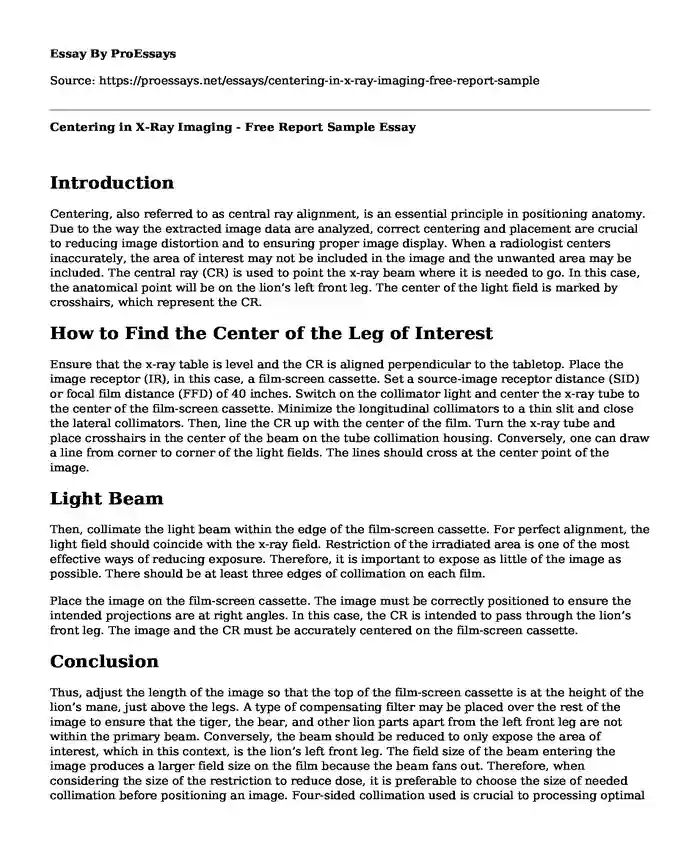Introduction
Centering, also referred to as central ray alignment, is an essential principle in positioning anatomy. Due to the way the extracted image data are analyzed, correct centering and placement are crucial to reducing image distortion and to ensuring proper image display. When a radiologist centers inaccurately, the area of interest may not be included in the image and the unwanted area may be included. The central ray (CR) is used to point the x-ray beam where it is needed to go. In this case, the anatomical point will be on the lion’s left front leg. The center of the light field is marked by crosshairs, which represent the CR.
How to Find the Center of the Leg of Interest
Ensure that the x-ray table is level and the CR is aligned perpendicular to the tabletop. Place the image receptor (IR), in this case, a film-screen cassette. Set a source-image receptor distance (SID) or focal film distance (FFD) of 40 inches. Switch on the collimator light and center the x-ray tube to the center of the film-screen cassette. Minimize the longitudinal collimators to a thin slit and close the lateral collimators. Then, line the CR up with the center of the film. Turn the x-ray tube and place crosshairs in the center of the beam on the tube collimation housing. Conversely, one can draw a line from corner to corner of the light fields. The lines should cross at the center point of the image.
Light Beam
Then, collimate the light beam within the edge of the film-screen cassette. For perfect alignment, the light field should coincide with the x-ray field. Restriction of the irradiated area is one of the most effective ways of reducing exposure. Therefore, it is important to expose as little of the image as possible. There should be at least three edges of collimation on each film.
Place the image on the film-screen cassette. The image must be correctly positioned to ensure the intended projections are at right angles. In this case, the CR is intended to pass through the lion’s front leg. The image and the CR must be accurately centered on the film-screen cassette.
Conclusion
Thus, adjust the length of the image so that the top of the film-screen cassette is at the height of the lion’s mane, just above the legs. A type of compensating filter may be placed over the rest of the image to ensure that the tiger, the bear, and other lion parts apart from the left front leg are not within the primary beam. Conversely, the beam should be reduced to only expose the area of interest, which in this context, is the lion’s left front leg. The field size of the beam entering the image produces a larger field size on the film because the beam fans out. Therefore, when considering the size of the restriction to reduce dose, it is preferable to choose the size of needed collimation before positioning an image. Four-sided collimation used is crucial to processing optimal quality images and accurate reading of the exposed field size.
Cite this page
Centering in X-Ray Imaging - Free Report Sample. (2023, Nov 16). Retrieved from https://proessays.net/essays/centering-in-x-ray-imaging-free-report-sample
If you are the original author of this essay and no longer wish to have it published on the ProEssays website, please click below to request its removal:
- Medicine Essay Example: A Stroke Symptoms and Treatment
- Paper Example on Gastroesophageal Reflux Disease
- Changes in the Approach to Management Since the Industrial Revolution Essay
- Organ Donation and Federal Laws Essay Example
- Company: Microsoft Corporation
- Essay Sample on 3 Best Weight Loss Programs: WW, Noom, Mayo Clinic
- Disseminated Intravascular Coagulation - Free Essay







